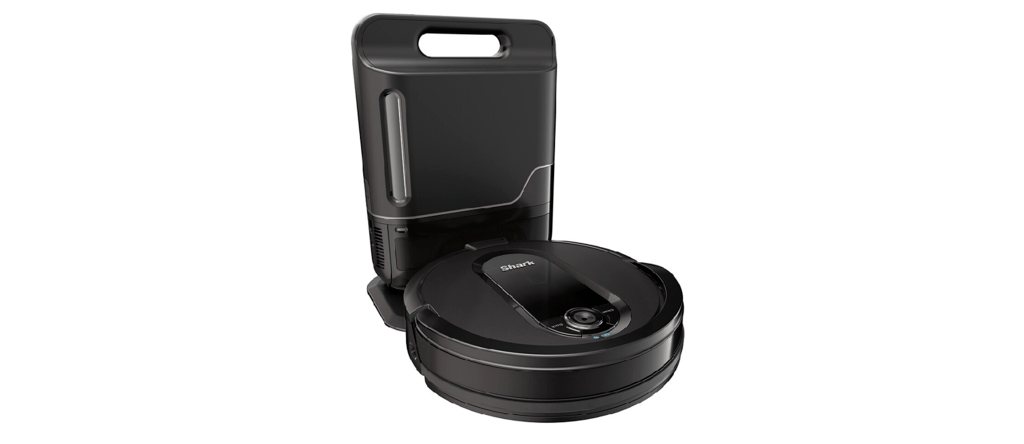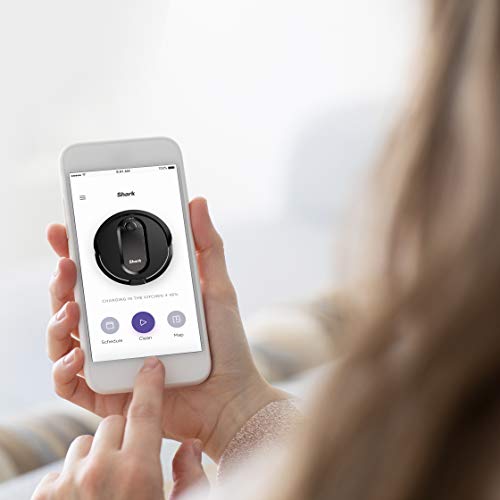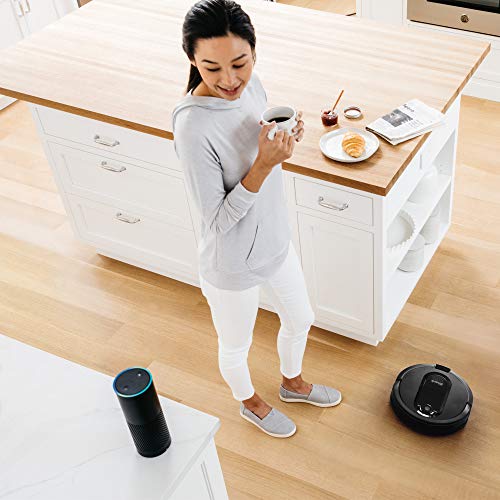After the Shark Ion models, the company went back to work to correct some underlying issues and to produce a robot that could keep up with the big boys, namely iRobot and Neato. The result is the Shark IQ Auto-Empty (AE).
In this review, I will take a close look at the claims made by Shark to find out how they hold up under real-world situations. I will also address some of the complaints by owners and those thinking about buying the Shark IQ AE. Is this the next robot to beat? Let’s find out.
Who is the Shark IQ AE for?
The Shark IQ AE is a robot designed to take on the biggest names in the industry. They want to provide a vacuum that performs just as well for a fraction of the cost.
Because of this, the IQ is a model that wants to be in every home in America. The design features elements that make it more viable for larger homes, with the Recharge and Resume abilities. The navigation and mapping also integrate with smart homes making it an ideal robot for homes that already have smart appliances.
Since not every robot is designed for every home, the Shark IQ AE might not be the best fit for those living in smaller homes, apartments, or condos. There are less expensive robots that will handle these types of spaces better, such as the Roomba 890.
You may also find an aversion to the use of mobile apps and voice commands for the majority of the control and containment options. Homes without the use of a wireless network or smartphones will find that most of the technology go to waste.
Contents
Detailing the Shark IQ Auto-Empty
The Shark IQ AE makes a lot of claims. How do they translate into a real-world application of the robot? That’s what I aim to find out. Tag along as we look at each claim and find out if it works or not.
Forget About Vacuuming for a Month
This is a great claim, and the idea behind it is that the auto-empty feature of the Shark IQ AE is so complete that you don’t have to worry about your floors for 30 days. Because of the ability to schedule your robot, you can effectively have it run every day for a month without having to restart a schedule or create a new one.
Once the robot is scheduled, it will run through your entire home and clean as instructed. Unlike other robots on the market, though, when the robot docks for a battery recharge, the auto-empty feature kicks in. This is similar to the self-emptying feature of the Roomba i7+ and s9+.
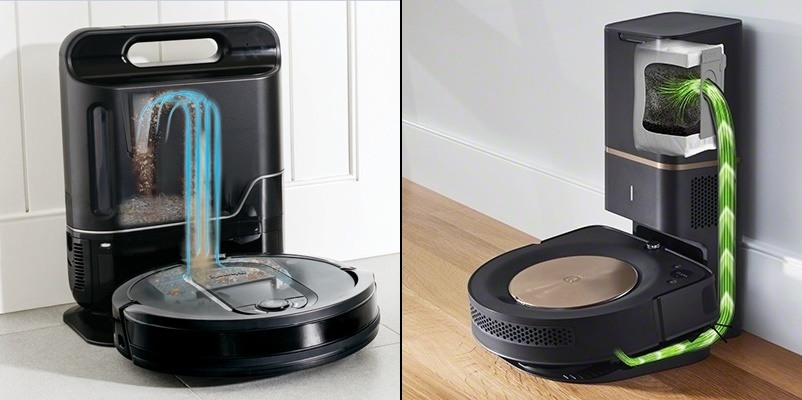
The idea is that the collection bin is emptied by a motor in the charging station that suctions out the collection bin when the robot docks. The 30-day claim is made because the capacity of the charging dock’s container can hold 30 robot bin’s worth of debris. If you run the robot every day for a month, well, you can do the math.
Does it Work?
Letting your robot vacuum have run of the house for 30-days is a dream come true. Unfortunately, nightmares are dreams, too. Without checking on your robot, things are bound to go wrong.
The 30-day claim isn’t about unattended care, though, which would be a flat out lie. Instead, the claim is made about the robot’s ability to empty its bin without the need for assistance from you. In this respect, it does pass the claim.
The robot’s bin is tiny, with a capacity of only 0.16L, it doesn’t hold very much debris. As an example, the Roomba 600 series robots have a capacity of 0.3L, almost twice the size, and even these fill up too quickly.
What is true is that the charging station bin can hold at least 30 empties of the robot’s collection tray with ease. The hard part, though, is that this won’t take 30 days to fill up. In a real-world situation, the robot will recharge at least once during a standard clean of 900 to 1000 square feet. More often if you have a lot of rooms or furniture.
At a minimum, the tray gets full and is emptied twice per session, usually three times or more, though. This means the charging station bin will become full in a maximum of 15 days or less.
Still, two weeks without having to worry about cleaning up after your robot is a good thing, right? If only it worked that way. Later on, we will discuss the combination brush roll, side brushes, and their abilities, and you will see what I mean.
For now, don’t purchase the Shark IQ AE thinking you can go a month without checking on it or emptying the larger bin. You can expect to empty the large collection bin at least weekly, but most likely more often than that.
Bottom Line: The 30-day claim is bold, but doesn’t hold up. The charging stations collection bin will hold 30 bin’s worth of debris, but it will only take 10 to 15 days to fill it, at most.
Self-Cleaning Brush Roll Eliminates Maintenance
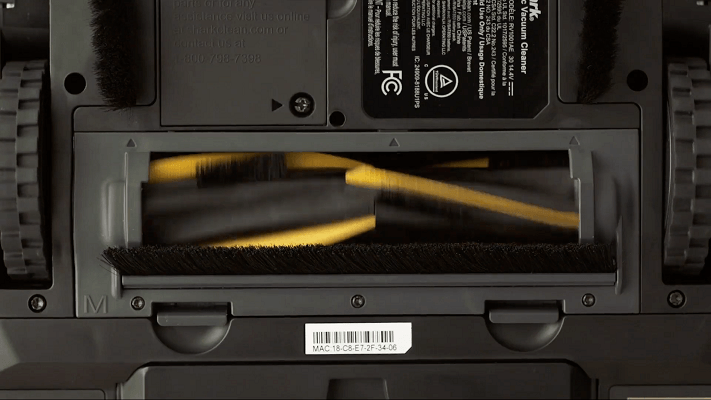
Another bold claim from Shark about the IQ AE is that the combination brush roll will clean itself. Ever since we have had vacuums, one of the worst parts about machinate was detangling the brush roll from pet hair, carpet fibers, string, and other strands of who-knows-what.
The idea that your brush roll will clean itself is one that makes the entire process more automated. Shark attacks this problem by placing a stationary brush near the airflow port. This brush scrapes the brush roll as it rotates, helping to remove any hairs or strings that may end up wrapped around it.
Does it Work?
When you set the Shark IQ AE out for its first run, you will most likely see where it has cleaned, and you will be excited. Rightfully so, having a clean floor that you didn’t have to touch is great.
Once you flip the robot over, though, the disappointment will begin to set in. There are a few issues with the self-cleaning brush roll that you need to be aware of before making your purchase.
First, this is not a new concept. Many robot vacuums have a similar feature using a stationary brush to clean off the rollers. None of them work quite right, including the one found on the Shark IQ.
The main issue is that for most pet owners or persons with long hair, there will be a lot. I mentioned above about the tiny collection bin on the robot, and this is where it comes into play. In an ideal world, the robot would return to the charging station and empty the bin when it gets full. We don’t live in an ideal world.
For some reason, there isn’t a sensor that alerts the robot that the bin is full. Instead, it relies on the frequency at which it needs to recharge to empty the tray on a more regular basis. The problem, then, is that the battery lasts longer than it takes to fill the collection bin, which overflows, fills the air chamber, and clogs the brush that is meant to clean off the roller.
Instead of bringing you less maintenance, the Shark IQ AE brings you more. Now you need to regularly clean off the brush roll, the stationary brush, empty the airflow chamber, and the collection bin.
The good news, though, is that the brush roll itself does keep reasonably clean. There will still be tangles, of course, but for the most part, it stays hair-free. It comes at the cost of extended routine maintenance for you, though, which can be a buzzkill.
Bottom Line: It is a noble effort, but the Shark IQ AE hasn’t quite got the cleaning of the brush roll down yet. While other factors go into the tangling of the brush roll, the fact remains it still gets wrapped.
Designed for Homes with Pets and Allergens
The Shark IQ AE claims to be designed for homes with pets. This is due to their suction power, dual edge brushes, and filtration.
The suction power is among the highest in the industry, with the IQ AE producing about 2000pa on carpeting. The power helps loosen and lift the dirt and debris from the carpet fibers and pulls in swept-up debris from the side brushes.
The IQ has two side brushes so that it can travel up and down your baseboards and room edges in any direction. The twin side brushes work to sweep loose debris from the outer edges of the robot to the center where it can be gathered by the suction power and the brush roller for collection.
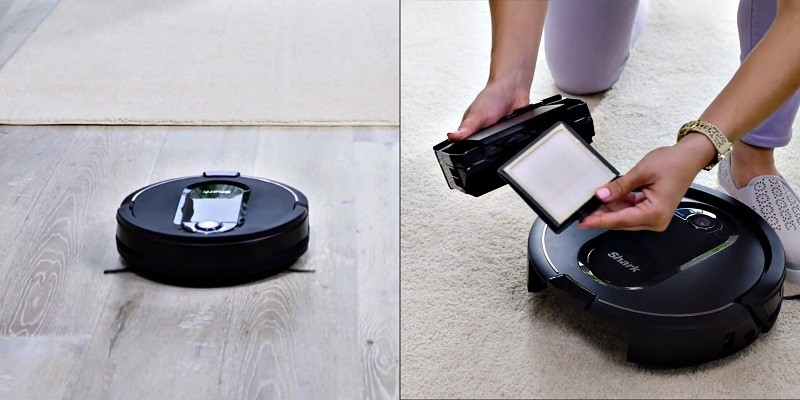
The filter is a HEPA style filter designed to capture in-home allergens such as pet dander, pollen, and dust mites, or other particles your pets may track in from their visits outdoors.
Does it Work?
The claim is valid, though misplaced. The filtration is top-notch, as all HEPA filters are. The filter itself is a bit on the smaller side, but it does what it is designed to do.
The filter will collect particles down to 3 microns in size, which is enough to collect up to 99 percent of in-home allergens. Also, the suction power on carpeting is high and will collect almost anything put into the airflow chamber.
The side brushes, though, miss the mark a little. There are two of them, they are angled, and they do sweep up debris from the outer edges of the robot. However, they don’t get deep into corners as the claim says, and the edge cleaning can be hit or miss.
While it doesn’t happen every time, the baseboards of some owners remain dusty or covered in pet hair after a pass or two of the robot. Part of this is the design. Unlike Neato, who introduced the D-shaped front end, and the Roomba s9 who copied it, the Shark IQ is round in shape and by design can’t get along straight edges or in right-angled corners very well.
The main issue with the claim of being for homes with pets is the brush roller system, once again. The small capacity collection bin overfilling and causing the airflow chamber to become clogged make the collection of pet hair virtually meaningless.
While the airflow is unobstructed and the brushes are full of hair, the Shark IQ AE will collect all manner of pet hair, string, and human hair. However, it is hard to collect anything when there is nowhere to put it, and airflow is reduced to almost zero. This often happens with this model.
Bottom Line: Having a home with shedding pets will still get cleaner with the Shark IQ than some other Shark models and older models of different brands. If you keep the robot clean daily, it will help control the shed hair problem you have.
Multiple Control Sources Give You Options
Like most modern robot vacuums, there are more than just local controls to allow you to run and program the robots.
There are local controls, where you can start and stop a cleaning cycle, return the robot to the charging station, and turn the unit on and off. If you do not have a smartphone or tablet to use the mobile app or voice controls, you will be limited to these few basic options.
The Mobile app is the major point of control, where you can use the mapping features to view and interact with the map created by the robot. This will give you more options, such as schedule making, digital containment, status reports, and much more.
With wireless communications, you also have the ability to use voice commands through Amazon Alexa and Google Assistant devices.
Does it Work?
The local controls are still in place to give persons without wireless home networks the opportunity to use the robots. You will lose most of the features and advancements without the use of the mobile app, though. This is true for most robots with wireless communications now, though, as a majority of the features and controls are done digitally.
The mobile app allows you to program the robot and interact with the map. Here you can select individual rooms for the robot to clean, effectively containing the robot to a specific area without the need for physical containment options.
Creating schedules is the second most useful feature, though, and will save you time, effort, and frustration. You can have your floors cleaned when you aren’t home, which is a relief, as the robot can become quite noisy.
The main problem with the mobile app is the app itself. While intuitive, user-friendly, and easy to read maps, the app crashes a lot. When it doesn’t crash, it freezes, and many users find they have to force stop and restart five or six times to get it to stay connected.
The voice commands are still limited. In fact, through the Alexa skill, you only get six control options. This is a far cry from the near 30 commands of a Roomba s9, but it is much better than the two commands of a Roborock S6.
Bottom Line: All of the control options work. The app has some difficulties staying connected, but SharkNinja is actively addressing this issue.
Shark claims to use innovative and cutting-edge navigation methods, dubbed IQ Navigation. This camera-based vSLAM navigation method uses images and sensor reports to build a map for the robot to follow.
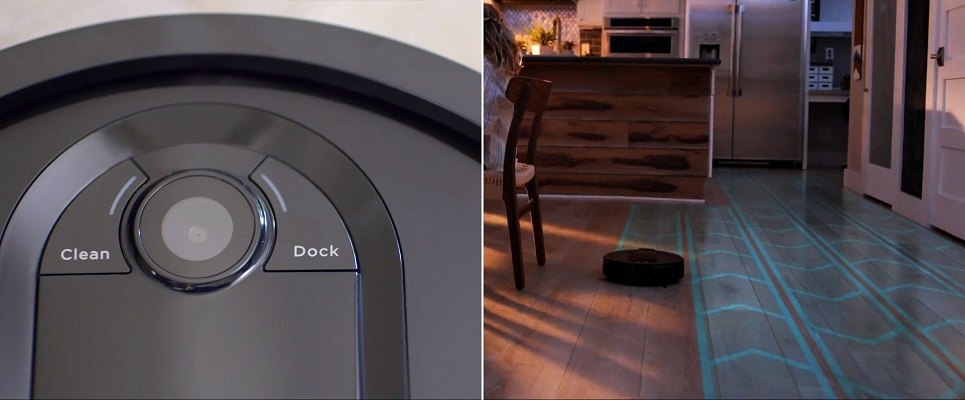
The map is represented in 3-D and can be seen on the mobile app. While navigating your home, the robot will use forward and back parallel lines to avoid missing any spots.
If you need to prevent access to certain areas of a room or your home, Shark also provides a roll of Bot Boundary tape so you can easily block access to specific areas without the need for baby gates, shut doors, or heavy object strewn about your floors.
Does it Work?
The IQ Navigation isn’t anything excitingly new. Camera-based navigation and mapping have been around for a while. I can say that Shark has introduced some of the latest vSLAM algorithms that are only used by some of the bigger names in the field. All-in-all, though, it is the same thing with a little bit more accuracy.
That accuracy, though, removes most of the missed spots that some vacuums can have, even going in back and forth parallel lines. There will still be missed spots, and for all of the great things the vSLAM software does, the Shark IQ AE has an above-average chance of not finding the charging station.
Many users report that they come home daily to find the robot dead, unable to dock, and usually within feet of the charging station. For some reason, the guide sensor to the dock doesn’t provide enough detailed directions to get the robot all the way home.
The mapping works, though, as long as you give the robot enough trials at running around your home. Over 80 percent of the current owners report this takes about five to 10 runs to create a solid, detailed map. The other 20 percent have given up on getting a full workable map with a few reports stating they have attempted over 50 runs.
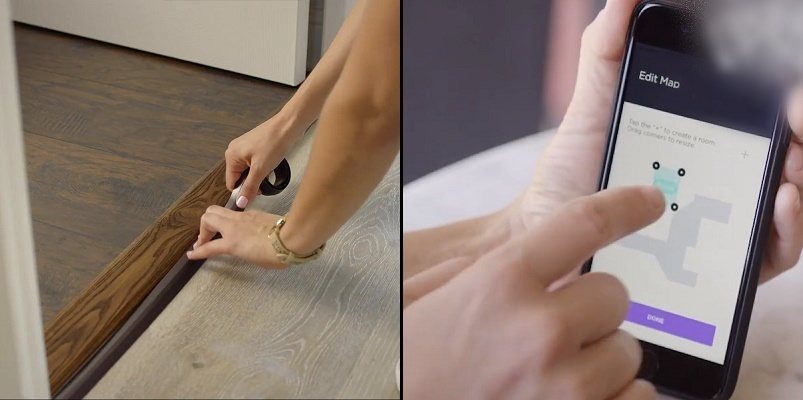
It is also advised to use the digital containment found on the mobile app. The physical containment isn’t the greatest invention. Bot Boundary tape is a magnetic tape strip that must be cut to size and placed where you want the robot to avoid.
It is a time-consuming process, can get messy, and if you don’t get the tape positioned and sized exactly right, the tape may be ignored or avoided to your displeasure. It is better than nothing, though, and for smaller areas that you don’t want the robot to clean, it works fairly well.
Bottom Line: A lot of big words are used to state that the technology for navigation and mapping are the same old methods. They work, of course, but it isn’t ground-breaking technology.
Specifications Chart
Let’s take a look at all the features, options and details of the Shark IQ Auto-Empty to give you an overview of what you care getting from the robot and its accessories.
| Shark IQ Auto-Empty | |
| Size | 12.9×12.6×3.5 inches |
| Weight | 5.87 pounds |
| Navigation | vSLAM |
| Battery | Lithium-Ion |
| Runtime | Up to 60 minutes |
| Charge Time | 3 hours |
| Automatic Recharge | Yes |
| Entire Level Clean | Yes |
| Filter | HEPA |
| Drop Sensors | Yes |
| Bump Sensors | Yes |
| Dirt Detection Sensors | No |
| Camera Navigation | Yes |
| Wireless Communications | Yes |
| Mobile App | Yes |
| Voice Controls | Yes |
| Floor Types | All |
| Room Select Cleaning | Yes |
| Collection Bin Capacity | 0.16L |
| Washable Collection Bin | No |
| Automatic Collection Bin Emptying | Yes |
| Side Brushes | 2 Side Brushes |
| Containment | Bot Boundary Tape |
| Warranty | 1 year |
| Price | Check on Amazon |
Comparisons with Other Robot Vacuums
Wondering how the Shark IQ AE holds up against some of the competition in the field? I have you covered.
Shark IQ AE Vs. Roomba i7+
The Roomba i7+ has the same auto-empty feature as the Shark IQ AE. Actually, the i7+ was the first robot in the industry with such a feature. All other aspects between the two models, as far as the list goes, are similar. They both have HEPA filtration, Recharge and Resume capabilities, vSLAM navigation, and mapping as well as mobile apps and voice controls.
The app for the Roomba is much better and has a lot more features, including Imprint Technology, that allows the robot to communicate with the Braava M6 mopping robot and store up to 10 different floor plans.
The big difference, though, is that the Roomba i7+ cleans carpeting better, has a much larger collection bin, and doesn’t get clogged when cleaning. The brushless extractors can free themselves from tangles and don’t get stuck on medium, or high-piled carpeting. You can read the full comparison between the Shark IQ self empty and the Roomba i7+ here.
> Check out the Roomba i7+ on Amazon <
Shark IQ AE Vs. Neato D6 Connected
Neato is the largest competitor of the Roomba since they first came out. It is no wonder that the Neato D6 and D7 models are some of the best top-tier robots on the market. If you want to see the differences and find out why I like the D6 over the D7, check out our review here.
The D6 has advanced features that actually work. While it doesn’t empty itself as the Shark IQ AE does, it has a giant collection bin, long battery life, and cleans deeper on the carpet. If self-emptying is that important to you, Roomba i7+, s9+, and Shark IQ AE are the only options you have.
Neato’s D-Shape also allows the D6 to get into corners and along edges much better than the IQ can. The mobile app is where the biggest difference will come in. While it still has a few functionality flaws, the app doesn’t crash and is quite easy to navigate, sync, and use.
> Check out Neato BotVac D6 Connected on Amazon <
Shark IQ AE Vs. Roborock S6
Roborock is quietly making a name for themselves in the budget robot market. They have finally split form the Xiaomi partnership, and while they continue to make confusing robot names, even after the S5 and Xiaomi split, the truth is in action.
The S6 mopping robot doesn’t empty itself, and it isn’t the most efficient cleaning robot available. The Shark IQ cleans better, but it doesn’t mop. However, the mopping feature of the S6 is less than desirable, as well. So you aren’t missing much.
On hard flooring and carpeting, though, it compares well to the Shark IQ series. The enormous battery (5200mAh) keeps the robot going for over 2 hours. You will have to empty the collection bin yourself, but it does hold almost a full liter of debris.
You also get HEPA filtration and your choice of 2 mobile apps (it is still confusing, I know). There are flaws and a few issues. However, if you want to save money and have the option to keep your hard surfaces mopped and swept, the Roborock S6 is a decent 3-in-1 robot to choose.
> Check out the Roborock s6 on Amazon <
Frequently Asked Questions
Let’s take a moment to answer a few of the more popular questions about the Shark IQ Auto-Empty. If you have more questions or concerns, please use the comment section below.
Q. How long is the Shark IQ AE warranty, and how do I make a claim?
A. Shark gives you what they call the VIP warranty when you purchase through them. You get a full 90-days to evaluate the robot and return it for a refund if you are not satisfied. Once the 90 days are over, you get a 1-year warranty against defects, craftsmanship, or internal parts going bad. The warranty doesn’t cover removable items like the filters, brushes, or wheels.
Q. Can I contact Shark customer service?
A. You can call their customer service line at 877-581-7375 Monday through Friday between the hours of 9 am. and 9 pm. They are also available on Saturday between 9 am and 6 p. All times are Eastern.
Q. Where is the best place to purchase a Shark IQ?
A. The best place to purchase your Shark IQ is through the Shark website or through Amazon. I recommend Amazon because you are assured that your purchase is registered, and their customer service department is easier to get a hold of in the event you need to start a claim.
Q. Can The Shark IQ auto-empty be upgraded?
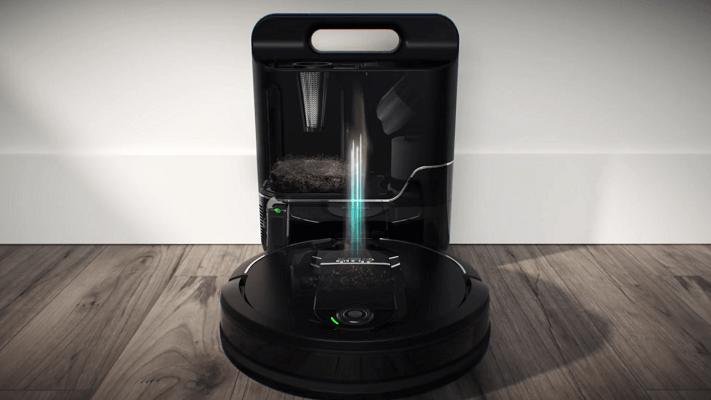
A. No. The Shark IQ Auto-Empty is the upgrade. You can opt for the less expensive Shark IQ. You lose the auto-empty feature, but you get a much larger collection bin (0.6L), more suction power (about 2200pa), and several other smaller differences that make the choice a difficult one.
Conclusion
The Shark IQ Auto-Empty is an advanced robot for a lower price than its competition. This makes it an attractive offer. However, for everything that is claimed and expected from the robot, it still performs like a modern mid-tier vacuum.
The technology is there, and it has a lot of potential, but there are still too many bugs to work out to call the IQ AE a top-tier competitor. Once the mobile app is straightened out, and Shark addresses the tiny collection bin situation, it can move up in the ranks.
If you have a larger home, the Recharge and Resume feature will come in handy, especially since it only runs about an hour per charge. There are a few examples in this industry where the “you get what you pay for” adage comes true. The Shark IQ Auto-Empty is one such example.
In a Nutshell
The Shark IQ Auto-Empty has a lot of potential to be a top-tier robot. However, it falls short on too many claims, and there are bugs to work out before it can be considered a Roomba-killer. For what it is, though, the purchase price and cleaning ability do make it a worthwhile investment.
What I Like
- Bagless collection bin holds up to 30 days worth of debris.
- Resumes cleaning after a battery charge to complete the assigned job.
- Dual side brushes allow the robot to clean edges in any direction.
What I Don’t Like
- Tiny collection bin easily overfills and causes congestion in the collection process.
- 60 minute runtime has the robot returning to the charger too often.
- Mobile app has flaws that need to be addressed.
